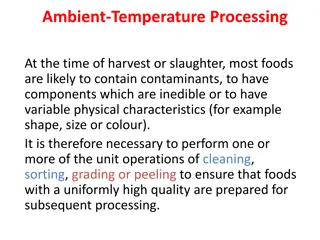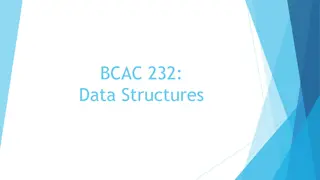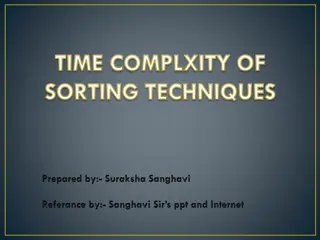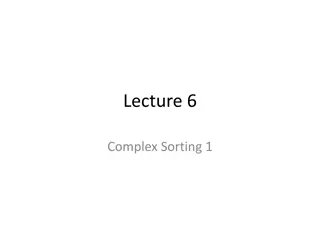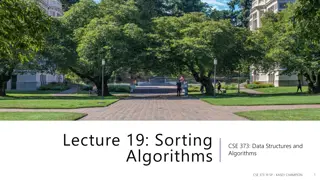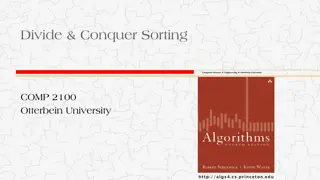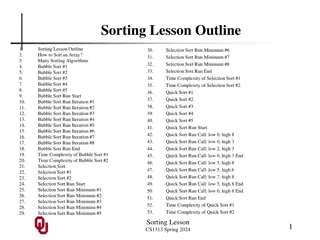Understanding Sorting Algorithms for Efficient Data Management
Sorting algorithms play a crucial role in organizing data efficiently. This content covers the fundamentals of sorting, emphasizing the importance of consistent ordering, space complexity, stability, and time efficiency in sorting algorithms. By understanding these key concepts, one can optimize data management operations for enhanced performance.
Download Presentation

Please find below an Image/Link to download the presentation.
The content on the website is provided AS IS for your information and personal use only. It may not be sold, licensed, or shared on other websites without obtaining consent from the author. Download presentation by click this link. If you encounter any issues during the download, it is possible that the publisher has removed the file from their server.
E N D
Presentation Transcript
CSE 332: Data Abstractions Sorting I Spring 2016
Sorting Input an array A of data records a key value in each data record a comparison function which imposes a consistent ordering on the keys Output sorted array A such that For any i and j, if i < j then A[i] A[j] 3
Consistent Ordering The comparison function must provide a consistent ordering on the set of possible keys You can compare any two keys and get back an indication of a < b, a > b, or a = b (trichotomy) The comparison functions must be consistent If compare(a,b) says a<b, then compare(b,a) must say b>a If compare(a,b) says a=b, then compare(b,a) must say b=a If compare(a,b) says a=b, then equals(a,b) and equals(b,a) must say a=b 4
Why Sort? Provides fast search: Find kth largest element in: 5
Space How much space does the sorting algorithm require? In-place: no more than the array or at most O(1) addition space out-of-place: use separate data structures, copy back External memory sorting data so large that does not fit in memory 6
Stability A sorting algorithm is stable if: Items in the input with the same value end up in the same order as when they began. Input Unstable sort Adams Smith Washington Jackson Black White Wilson Thompson Brown Jones Stable Sort Adams Smith Black Jackson Washington White Wilson Brown Jones Thompson Adams Black Brown Jackson Jones Smith Thompson Washington White Wilson 1 2 4 2 4 1 4 2 3 3 1 1 2 2 2 3 3 4 4 4 1 1 2 2 2 3 3 4 4 4 7
Time How fast is the algorithm? requirement: for any i<j, A[i] < A[j] This means that you need to at least check on each element at the very minimum Complexity is at least: And you could end up checking each element against every other element Complexity could be as bad as: The big question: How close to O(n) can you get? 8
Sorting: The Big Picture Simple algorithms: O(n2) Fancier algorithms: O(n log n) Comparison lower bound: (n log n) Specialized algorithms: O(n) Handling huge data sets Insertion sort Selection sort Heap sort Merge sort Quick sort (avg) Bucket sort Radix sort External sorting 9
Demo (with sound!) http://www.youtube.com/watch?v=kPRA0W1kECg 10
Selection Sort: idea 1. Find the smallest element, put it 1st 2. Find the next smallest element, put it 2nd 3. Find the next smallest, put it 3rd 4. And so on 11
Try it out: Selection Sort 31, 16, 54, 4, 2, 17, 6 12
Selection Sort: Code void SelectionSort (Array a[0..n-1]) { for (i=0; i<n; ++i) { j = Find index of smallest entry in a[i..n-1] Swap(a[i],a[j]) } } Runtime: worst case best case : average case : : 13
Bubble Sort Take a pass through the array If neighboring elements are out of order, swap them. Repeat until no swaps needed Wost & avg case: O(n2) pretty much no reason to ever use this algorithm 14
Insertion Sort 1. Sort first 2 elements. 2. Insert 3rd element in order. (First 3 elements are now sorted.) 3. Insert 4th element in order (First 4 elements are now sorted.) 4. And so on 15
How to do the insertion? Suppose my sequence is: 16, 31, 54, 78, 32, 17, 6 And I ve already sorted up to 78. How to insert 32? 16
Try it out: Insertion sort 31, 16, 54, 4, 2, 17, 6 17
Insertion Sort: Code void InsertionSort (Array a[0..n-1]) { for (i=1; i<n; i++) { for (j=i; j>0; j--) { if (a[j] < a[j-1]) Swap(a[j],a[j-1]) else break } } Runtime: Note: can instead move the hole to minimize copying, as with a binary heap. worst case best case : average case : : 18
Insertion Sort vs. Selection Sort Same worst case, avg case complexity Insertion better best-case preferable when input is almost sorted one of the best sorting algs for almost sorted case (also for small arrays) 19
Sorting: The Big Picture Simple algorithms: O(n2) Fancier algorithms: O(n log n) Comparison lower bound: (n log n) Specialized algorithms: O(n) Handling huge data sets Insertion sort Selection sort Heap sort Merge sort Quick sort (avg) Bucket sort Radix sort External sorting 20
Heap Sort: Sort with a Binary Heap Worst Case Runtime: 21
In-place heap sort Treat the initial array as a heap (via buildHeap) When you delete the ith element, put it at arr[n-i] It s not part of the heap anymore! 4 7 5 9 8 6 10 3 2 1 heap part sorted part 5 7 6 9 8 10 4 3 2 1 arr[n-i]= deleteMin() heap part sorted part 22
AVL Sort Insert nodes into an AVL Tree Conduct an In-order traversal to extract nodes in sorted order Worst Case Runtime: 23
Divide and Conquer Very important strategy in computer science: Divide problem into smaller parts Independently solve the parts Combine these solutions to get overall solution Idea 1: Divide array in half, recursively sort left and right halves, then merge two halves known as Mergesort Idea 2 : Partition array into small items and large items, then recursively sort the two sets known as Quicksort 24
Mergesort 8 2 9 4 5 3 1 6 Divide it in two at the midpoint Sort each half (recursively) Merge two halves together 25
Mergesort Example 4 5 1 6 8 2 9 3 Divide 8 2 9 4 5 3 1 6 Divide 9 4 1 6 8 2 5 3 Divide 1 element 8 2 9 4 5 3 1 6 Merge 2 8 4 9 3 5 1 6 Merge 2 4 8 9 1 3 5 6 Merge 1 2 3 4 5 6 8 9 26
Merging: Two Pointer Method Perform merge using an auxiliary array 2 4 8 9 1 3 5 6 Auxiliary array 27
Merging: Two Pointer Method Perform merge using an auxiliary array 2 4 8 9 1 3 5 6 Auxiliary array 1 28
Merging: Two Pointer Method Perform merge using an auxiliary array 2 4 8 9 1 3 5 6 Auxiliary array 1 2 3 4 5 29
Merging: Finishing Up Starting from here j i target Left finishes up i j copy target or first copy this Right finishes up j i then this 30 target
Merging: Two Pointer Method Final result 1 2 3 4 5 6 8 9 Auxiliary array 1 2 3 4 5 6 Complexity? Stability? 31
Merging Merge(A[], Temp[], left, mid, right) { Int i, j, k, l, target i = left j = mid + 1 target = left while (i < mid && j < right) { if (A[i] < A[j]) Temp[target] = A[i++] else Temp[target] = A[j++] target++ } if (i > mid) //left completed// for (k = left to target-1) A[k] = Temp[k]; if (j > right) //right completed// k = mid l = right while (k > i) A[l--] = A[k--] for (k = left to target-1) A[k] = Temp[k] } 32
Recursive Mergesort MainMergesort(A[1..n], n) { Array Temp[1..n] Mergesort[A, Temp, 1, n] } Mergesort(A[], Temp[], left, right) { if (left < right) { mid = (left + right)/2 Mergesort(A, Temp, left, mid) Mergesort(A, Temp, mid+1, right) Merge(A, Temp, left, mid, right) } } What is the recurrence relation? 33
Iterative Mergesort Merge by 1 Merge by 2 Merge by 4 Merge by 8 35
Iterative Mergesort Merge by 1 Merge by 2 Merge by 4 Merge by 8 Merge by 16 copy Iterative Mergesort reduces copying Complexity? 36
Properties of Mergesort In-place? Stable? Sorted list complexity? Nicely extends to handle linked lists. Multi-way merge is basis of big data sorting. Java uses Mergesort on Collections and on Arrays of Objects. 37



